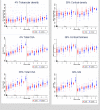Impaired Bone Architecture in Peripubertal Children With HIV, Despite Treatment With Antiretroviral Therapy: A Cross-Sectional Study From Zimbabwe
- PMID: 36426511
- PMCID: PMC9996028
- DOI: 10.1002/jbmr.4752
Impaired Bone Architecture in Peripubertal Children With HIV, Despite Treatment With Antiretroviral Therapy: A Cross-Sectional Study From Zimbabwe
Abstract
HIV infection has multi-system adverse effects in children, including on the growing skeleton. We aimed to determine the association between chronic HIV infection and bone architecture (density, size, strength) in peripubertal children. We conducted a cross-sectional study of children aged 8 to 16 years with HIV (CWH) on antiretroviral therapy (ART) and children without HIV (CWOH) recruited from schools and frequency-matched for age strata and sex. Outcomes, measured by tibial peripheral quantitative computed tomography (pQCT), included 4% trabecular and 38% cortical volumetric bone mineral density (vBMD), 4% and 38% cross-sectional area (CSA), and 38% stress-strain index (SSI). Multivariable linear regression tested associations between HIV status and outcomes, stratified by sex and puberty (Tanner 1-2 versus 3-5), adjusting for age, height, fat mass, physical activity, and socioeconomic and orphanhood statuses. We recruited 303 CWH and 306 CWOH; 50% were female. Although CWH were similar in age to CWOH (overall mean ± SD 12.4 ± 2.5 years), more were prepubertal (ie, Tanner 1; 41% versus 23%). Median age at ART initiation was 4 (IQR 2-7) years, whereas median ART duration was 8 (IQR 6-10) years. CWH were more often stunted (height-for-age Z-score <-2) than those without HIV (33% versus 7%). Both male and female CWH in later puberty had lower trabecular vBMD, CSA (4% and 38%), and SSI than those without HIV, whereas cortical density was similar. Adjustment explained some of these differences; however, deficits in bone size persisted in CWH in later puberty (HIV*puberty interaction p = 0.035 [males; 4% CSA] and p = 0.029 [females; 38% CSA]). Similarly, puberty further worsened the inverse association between HIV and bone strength (SSI) in both males (interaction p = 0.008) and females (interaction p = 0.004). Despite long-term ART, we identified deficits in predicted bone strength in those living with HIV, which were more overt in the later stages of puberty. This is concerning, as this may translate to higher fracture risk later in life. © 2022 The Authors. Journal of Bone and Mineral Research published by Wiley Periodicals LLC on behalf of American Society for Bone and Mineral Research (ASBMR).
Keywords: ANALYSIS/QUANTIFICATION OF BONE; DISEASES AND DISORDERS OF/RELATED TO BONE; EPIDEMIOLOGY.
© 2022 The Authors. Journal of Bone and Mineral Research published by Wiley Periodicals LLC on behalf of American Society for Bone and Mineral Research (ASBMR).
Conflict of interest statement
The authors declare no conflicts of interest.
Figures


References
-
- UNICEF . Reimagining a resilient HIV response for children, adolescents and pregnant women living with HIV. World AIDS Day Rep 2020. 2020;16. Available from: http://www.childrenandaids.org/sites/default/files/2020-12/2020WorldAIDS...
-
- Frigati L, Ameyan W, Cotton M, et al. Chronic comorbidities in children and adolescents with perinatally acquired HIV infection in sub‐ Saharan Africa in the era of antiretroviral therapy. Lancet Child Adolesc Health. 2020;4642(20):30037. - PubMed
-
- Feucht UD, Van BL, Becker PJ, Kruger M. Growth in HIV‐infected children on long‐term antiretroviral therapy. Trop Med Int Health. 2016;21(5):619‐629. - PubMed
Publication types
MeSH terms
Grants and funding
LinkOut - more resources
Full Text Sources
Medical
Research Materials

